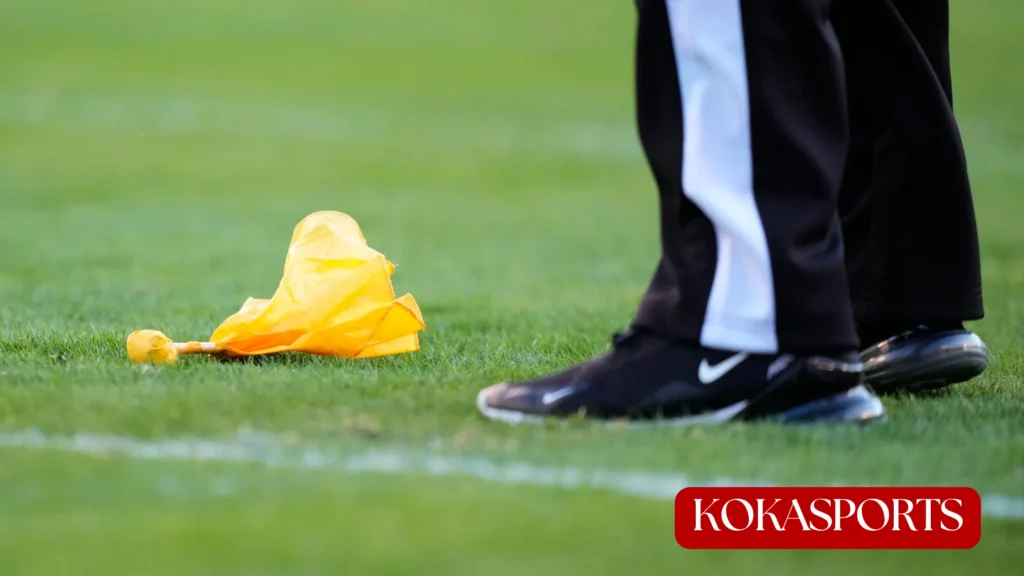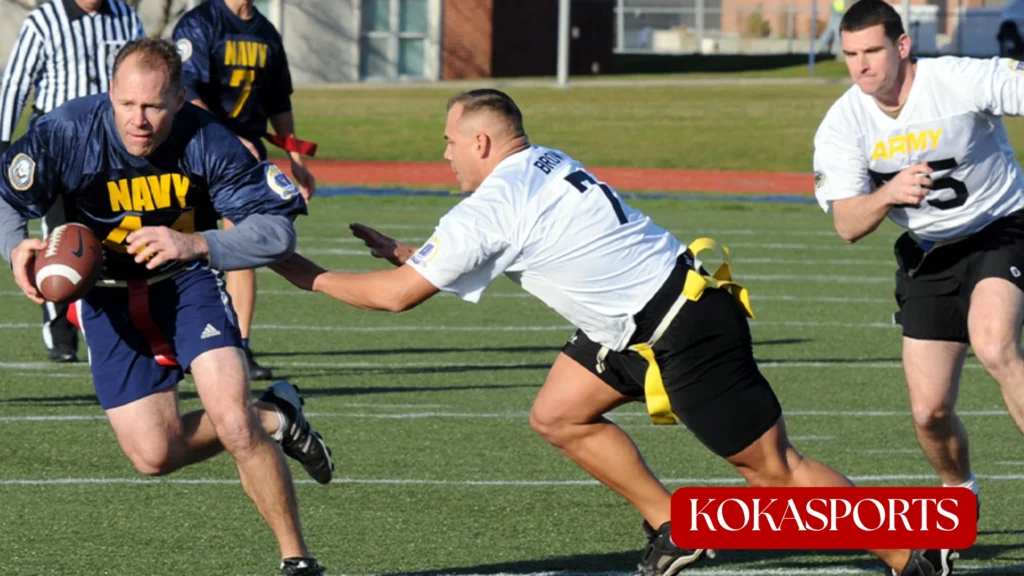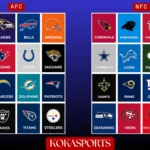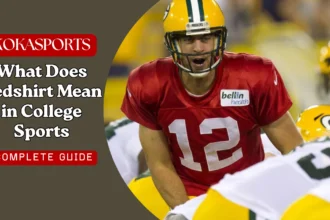When you watch a football game, seeing a yellow flag fly through the air can change everything in an instant. But what does that flag mean? In American football, the word “flag” actually has two completely different meanings. In the NFL and tackle football, a flag signals that a penalty has been committed. In flag football, the flag is a piece of equipment that players wear as part of their uniform. Both types of flags play crucial roles in how the game is played and enjoyed at every level.
This guide will help you learn about flags in football, how penalty calls work in the NFL, and what makes flag football such a popular sport for young players and adults alike.
What Does a Flag Mean in Football?

The Purpose of the Penalty Flag in NFL Football
In professional American football and tackle football, a penalty flag is a bright yellow flag made of weighted cloth that game officials throw onto the field when they spot a rule violation. The referee and other officials carry these flags in their back pockets during play. When they see a foul, they pull out the flag and toss it into the air or onto the ground near where the violation happened.
The football penalty flag first appeared in the 1940s. Before that, referees used horns and whistles to signal rule breaks, which created confusion because whistles were also used to stop play for other reasons. College football officials first used flags in 1941, and the NFL adopted them soon after. This simple yellow cloth became one of the most recognized symbols in all of sports.
When you see yellow flags on the ground during a game, it means someone broke a rule. The officials will then discuss what happened, announce the penalty, and determine how many yards the team loses or gains.
Common Reasons Why a Flag Is Thrown in the NFL
The flags mean different things depending on what rule was broken. Here are the most common reasons why officials throw the flag:
Holding happens when an offensive or defensive player grabs another player’s jersey or body to prevent them from moving freely. This penalty usually results in a penalty of 10 yards.
Offside occurs when a defensive player crosses the line of scrimmage before the ball is snapped. This is a 5-yard penalty that gives the offense a fresh set of downs.
False start happens when an offensive player moves before the center snaps the football. The play stops immediately, and the offense loses five yards.
Pass interference is called when a player illegally contacts an opponent who is trying to catch the ball. Defensive pass interference is a major foul that can result in a loss of field position equal to where the foul occurred.
Roughing the passer protects quarterbacks from hits after they’ve thrown the ball. This serious foul results in a 15-yard penalty and automatic first down.
Unsportsmanlike conduct covers actions like taunting opponents, excessive celebration, or using inappropriate language. These actions earn a 15-yard penalty and can lead to player ejections if repeated.
Each type of penalty affects the game differently. Some penalties result in a loss of yards only, while others also include loss of downs or automatic first downs for the other team.
Pre-Snap Penalties in Football
Pre-snap penalties occur before the play even begins. These violations happen during the setup phase when teams line up and prepare for the ball is snapped. Common examples include:
- False start: When an offensive player moves after getting set
- Encroachment: When a defensive player touches an opponent before the snap
- Neutral zone infraction: When a defender jumps into the neutral zone and causes an offensive player to react
- Delay of game: When the offense doesn’t snap the ball within the play clock
Pre-snap penalties can kill offensive drives by pushing teams backward and creating difficult down-and-distance situations. A football coach must teach players to stay disciplined before the play starts.
Read More: How Many NFL Teams Are There in 2025? Full List & Divisions
How Football Penalties Work and the Penalty Flag System

The Role of Officials in Throwing a Penalty Flag
NFL game officials work as a crew of seven people on the field. Each official has specific responsibilities and watches different areas of play. The referee (the official wearing a white hat) leads the crew and makes final decisions on penalty calls.
When an official spots a violation, they immediately throw his yellow flag onto the spot on the field where the penalty occurred. After the play ends, officials gather to discuss what they saw. The referee then turns on their microphone and announces the penalty to everyone in the stadium and watching at home.
The announcement includes which team committed the foul, what type of penalty it was, and how it will be assessed. For example: “Holding, offense, number 72. Ten-yard penalty from the previous spot on the field, repeat second down.”
Major vs. Minor Football Penalties
Football penalties come in three main sizes based on yardage:
| Penalty Type | Yardage Loss | Common Examples |
|---|---|---|
| Minor | 5 yards | Offside, false start, delay of game |
| Moderate | 10 yards | Holding, illegal use of hands |
| Major | 15 yards | Personal fouls, roughing the passer, unsportsmanlike conduct |
The size of the penalty depends on how serious the rule violation is. Minor penalties happen frequently and are often unintentional. Major penalties involve player safety or sportsmanship and carry heavier consequences.
Some penalties are assessed from the spot where the foul occurred, while others are marked from the line of scrimmage or end of the play. An offensive penalty behind the line of scrimmage might be enforced from where the quarterback was standing, not where the play ended.
How Coaches and Players React to Penalty Flags
When officials throw the flag, coaches often react emotionally because penalties can change game outcomes. The head coach can request an explanation from officials but cannot challenge most penalty calls. Only specific types of plays are reviewable.
Teams that commit too many penalties hurt themselves badly. Each flag costs yards, momentum, and sometimes points. Disciplined teams know how to play hard without breaking rules. The best players on the field stay focused on technique rather than letting frustration lead to unsportsmanlike penalty calls.
The offense can also decline the penalty if the result of the play was better than accepting the penalty yardage would be.
What Is Flag Football? How It Differs from NFL Football

The Basics of Flag Football
Flag football is a non-contact version of American football where players wear flags attached to a belt around their waist instead of tackling each other. The sport of flag football removes the physical collisions that happen in tackle football while keeping the strategy, teamwork, and excitement that make football fun.
Playing flag football means the defensive player must pull the flag from the ball carrier’s belt to stop their progress. Once the flag is pulled, the play ends, and the ball is marked where the carrier’s flags came off. This simple rule change makes the game much safer, especially for young players and recreational leagues.
The rules of flag football evolved from regular football to create opportunities for people who wanted to play football without the injury risks. Today, millions of children and adults play in organized flag football league programs across the country.
Essential Flag Football Equipment
Flag football equipment is much simpler than what’s needed for tackle football. Here’s what players need:
- Flag belt: A belt worn around the waist with two or three detachable flags hanging from each side
- Football: Usually a smaller, lighter ball appropriate for the age group
- Cones and field markers: To mark boundaries and the line of scrimmage
- Jerseys: Different colors for each team
- Cleats or athletic shoes: For traction and safety
The flags and belt are the most important pieces of flag football equipment. Quality flags should be flag approved by the league and designed to detach easily when pulled but not fall off accidentally. If a player’s flag inadvertently falls off before being pulled, the play usually continues until the player is touched.
Core Flag Football Rules
The main flag football rule differences from NFL football include:
No tackling or blocking: Physical contact is not allowed. A defensive player may only pull flags, not push or grab the ball carrier’s body.
Seven players per team: Most flag football teams play with seven people instead of eleven like in the NFL.
Smaller field size: Games are often played on fields that are 40-60 yards long instead of the full 100-yard NFL field.
No fumbles: If the ball carrier drops the ball, the play is dead where it hit the ground.
Limited rushing: Some leagues require the defensive player to start a certain distance behind the line of scrimmage before rushing the quarterback.
A legal flag pull happens when the defensive player cleanly removes at least one flag from the ball carrier’s belt without grabbing their body or clothing. This flag pull immediately stops the play.
Flag Football Penalties and How They’re Enforced
Common Penalties in Flag Football
Even though flag football is a non-contact sport, penalties in flag football still exist to keep games fair and safe. The most common flag football penalties include:
Flag guarding occurs when the ball carrier uses their hands, arms, or the ball itself to prevent defenders from pulling their flags. This is one of the most frequent violations in youth leagues. Examples of flag guarding include holding your arm over your flag, swatting at a defender’s hand, or spinning away while protecting your flag with the ball. It’s a penalty because it defeats the purpose of non-contact play. The penalty results in loss of down and the ball being spotted where the foul occurred.
Illegal contact happens when any player pushes, holds, or tackles instead of pulling flags. Since flag football involves no physical contact, any touching beyond a flag pull is a foul.
Offsides works the same as in the NFL—players must be on their side of the line of scrimmage when the ball is snapped.
Defensive holding prevents offensive players from running their routes freely.
Offensive screening is when blockers impede defenders without establishing legal position.
Most flag football penalties result in either a 5-yard penalty or 10-yard penalty depending on the league and severity of the violation.
How Referees Signal Penalties in Flag Football
Unlike NFL games where officials carry penalty flags, many flag football leagues use different methods. Referees might blow a whistle and use hand signals to indicate the penalty. When a foul happens, the referee stops play immediately and explains the penalty to both teams.
The penalty will be assessed from either the previous spot or from where the foul occurred. For example, holding behind the line of scrimmage might be marked from where the quarterback was standing, while a penalty beyond the line of scrimmage would be assessed from the spot of the violation.
Players should learn common referee hand signals like holding (grabbing one wrist), illegal contact (hands pushing forward), and offside (hands on hips).
Youth Flag Football Rules and Coaching Tips
Key Differences in Youth Flag Football Rules
Youth flag football rules are adapted to make the game age-appropriate and educational. The NFL FLAG program, which is the official youth flag football organization of the NFL, sets standards used by thousands of leagues nationwide.
Youth flag football typically features:
- Shorter game halves (15-20 minutes instead of full quarters)
- Smaller fields (about 40 yards long)
- Simplified penalty enforcement
- Required minimum playing time for all players
- No score kept in some younger age divisions
These modifications help children learn football fundamentals without the complexity or pressure of competitive high school football or college football.
Common Mistakes and Penalties in Youth Flag Football
Beginning players often commit a penalty without realizing it. The most common mistakes include:
- Flag guarding: Young players naturally protect their flags when being chased
- Early movement before the snap causing a false start
- Running out of bounds to avoid having their flag pulled
- Not knowing where the line of scrimmage is located
A good flag football coach teaches these following rules patiently. Instead of getting frustrated when kids make mistakes, effective coaches use penalties as teaching moments. Explaining why flag guarding is not allowed helps players learn fair play principles that apply beyond sports.
The Role of a Coach in Youth Flag Football
The football coach in youth leagues has responsibilities that go beyond winning games. They must:
- Teach basic flag football terms like line of scrimmage, lateral pass, and possession of the ball
- Explain how different penalties affect the game
- Model good sportsmanship and respect for referees
- Make sure every child feels included and valued
Coaches should emphasize skill development over competition, especially with younger age groups. Learning proper technique for pulling flags, catching passes, and maintaining proper spacing on the field builds confidence that helps players succeed as they grow.
NFL FLAG and the Rise of Youth Flag Football
What Is NFL FLAG
NFL FLAG is the official youth flag football program backed by the NFL. It partners with local leagues, schools, and community organizations to provide safe, structured flag football opportunities for children aged 4-17. The program has grown dramatically in recent years, with over 1 million participants across all 50 states.
NFL FLAG provides standardized rules, referee training, coach education, and flag football equipment to ensure quality experiences. The organization also hosts regional and national championship tournaments that give young players goals to work toward.
Recently, the program expanded to include women’s flag football as an official high school sport in multiple states. This growth shows how flag football is becoming recognized as a legitimate athletic activity rather than just a recreational alternative to tackle football.
How NFL FLAG Differs from Regular NFL Rules
While NFL FLAG uses football concepts similar to professional American football, key differences make it appropriate for youth players:
| Feature | NFL Rules | NFL FLAG Rules |
|---|---|---|
| Players | 11 per team | 5-7 per team |
| Contact | Full tackling allowed | No contact, flag pulling only |
| Field size | 100 yards | 40-70 yards (age dependent) |
| Game length | 60 minutes | 40-50 minutes |
| Kickoffs | Yes | No, possession of the ball alternates |
The NFL FLAG rule system prioritizes safety and inclusion. Every child gets meaningful playing time, and the reduced field size keeps games fast-paced and exciting. These adaptations let kids focus on learning football strategy and teamwork without the physical risks that concern many parents about tackle football.
Flag Football Terms Every Player Should Know
Common Flag Football Terms Explained
Learning flag football terms helps players communicate better and enjoy the game more fully. Here are essential terms that every player should know:
Line of scrimmage: The invisible line across the field where the ball is placed before each play. Both teams must line up on their side of this line when the ball is snapped.
Flag pull: The act of removing a flag from the ball carrier’s belt, which ends the play. A clean flag pull requires only touching the flag, not the player’s body.
Lateral pass: A throw that goes backward or sideways rather than forward. Teams can make unlimited lateral passes during a play.
Dead ball: A ball that is no longer in play. This happens after a flag is pulled, the ball goes out of bounds, or an incomplete pass.
Interception: When a defensive player catches a pass intended for an offensive player, giving their team possession of the ball.
First down: When the offense advances the ball past the marker line (usually 20 yards in flag football), they earn a new set of downs to continue their drive.
Rush count: In some flag football leagues, defenders must count to a certain number (like “one-Mississippi, two-Mississippi”) before they can rush the quarterback.
Intentional grounding: When a quarterback throws the ball away to avoid being deflagged, but no receiver is nearby. This is a penalty.
Knowing these terms helps players follow coach instructions and work together as flag football teams more effectively.
Conclusion
In the NFL and all levels of tackle football, penalty flags serve as crucial tools for maintaining fairness and player safety. When referees throw the flag, they’re enforcing rules that protect athletes and preserve the integrity of competition. A penalty has occurred, the penalty will be assessed, and the game continues with both teams knowing the boundaries of acceptable play.
The yellow penalty flag that lands on the field where the foul occurred represents accountability. Whether it’s a minor 5-yard penalty for being offside or a serious 15-yard penalty for unsportsmanlike conduct, these NFL penalty flags remind everyone that football has standards that all many players on the field must follow.
In flag football, the flags themselves represent something different but equally important—safety and inclusion. The flag football flags attached to each player’s flag belt allow people of all ages and abilities to experience the strategy and teamwork of football without collision risks. The sport of flag football welcomes everyone, from elementary school children in youth flag football programs to adults in competitive leagues and even emerging women’s flag football teams at the high school and college football levels.
Both types of flags in football matter because they make the game better. Penalty marker flags keep competition clean and fair, while flag football equipment keeps players safe and active. Whether you’re watching NFL games where officials occasionally throw his yellow flag, or you’re participating in a local flag football league where pulling flags replaces tackling, these simple pieces of cloth play fundamental roles in how American football is played, taught, and enjoyed across the country.
The football league organizations that embrace proper penalty enforcement and the flag football include programs that prioritize safety are building a stronger future for the sport at every level.
FAQs
What is flag football also known as?
Flag football is also known as non-contact or touch football.
What do flags in football mean?
Flags in football signal a rule violation or penalty on the field.
What are flags used for in soccer?
In soccer, flags are used by referees and linesmen to indicate offsides, fouls, or out-of-bounds calls.
What are football flags made of?
Football penalty flags are made of bright yellow cloth with a weighted material, usually sand or beans, in one end.




